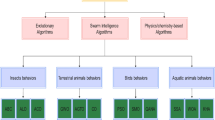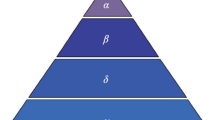Abstract
In this paper, we propose a new hybrid algorithm between the grey wolf optimizer algorithm and the genetic algorithm in order to minimize a simplified model of the energy function of the molecule. We call the proposed algorithm by Hybrid Grey Wolf Optimizer and Genetic Algorithm (HGWOGA). We employ three procedures in the HGWOGA. In the first procedure, we apply the grey wolf optimizer algorithm to balance between the exploration and the exploitation process in the proposed algorithm. In the second procedure, we utilize the dimensionality reduction and the population partitioning processes by dividing the population into sub-populations and using the arithmetical crossover operator in each sub-population in order to increase the diversity of the search in the algorithm. In the last procedure, we apply the genetic mutation operator in the whole population in order to refrain from the premature convergence and trapping in local minima. We implement the proposed algorithm with various molecule size with up to 200 dimensions and compare the proposed algorithm with 8 benchmark algorithms in order to validate its efficiency for solving molecular potential energy function. The numerical experiment results show that the proposed algorithm is a promising, competent, and capable of finding the global minimum or near global minimum of the molecular energy function faster than the other comparative algorithms.







Similar content being viewed by others
References
Agrawal S, Silakari S (2014) Fletcher–Reeves based particle swarm optimization for prediction of molecular structure. J Mol Graph Model 49:11–17
Anfinsen CB (1973) Principles that govern the folding of protein chains. Science 181:223–230
Bansal JC, Shashi KD, Katiyar VK (2010) Minimization of molecular potential energy function using particle swarm optimization. Int J Appl Math Mech 6(9):1–9
Bansal JC, Sharma H, Jadon SS, Clerc M (2014) Spider monkey optimization algorithm for numerical optimization. Memetic comput 6(1):31–47
Barbosa HJC, Lavor C, Raupp FM (2005) A GA-simplex hybrid algorithm for global minimization of molecular potential energy function. Ann Oper Res 138:189–202
De Jong KA (1985) Genetic algorithms: a 10 year perspective. In: International conference on genetic algorithms, pp 169–177
Deep K, Thakur M (2007) A new mutation operator for real coded genetic algorithms. Appl Math Comput 193(1):211–230
Deep K, Thakur M (2007) A new crossover operator for real coded genetic algorithms. Appl Math Comput 188(1):895–911
Draz̆ić M, Lavor C, Maculan N, Mladenović N (2008) A continuous variable neighborhood search heuristic for finding the three-dimensional structure of a molecule. Eur J Oper Res 185:1265–1273
Floudas CA, Klepeis JL, Pardalos PM (1999) Global optimization approaches in protein folding and peptide docking. American Mathematical Society, DIMACS Series in Discrete Metjematics and Theoretical Computer Science
Garcia S, Fernandez A, Luengo J, Herrera F (2009) A study of statistical techniques and performance measures for genetics-based machine learning, accuracy and interpretability. Soft Comput 13:959–977
Goldberg DE (1989) Genetic algorithms in search, optimization, and machine learning. Addison-Wesley, Boston
Hedar A, Ali AF, Hassan T (2011) Genetic algorithm and tabu search based methods for molecular 3D-structure prediction. Int J Numer Algebra Control Optim 1(1):191–209
Holland JH (1975) Adaptation in aatural and artificial systems. University of Michigan Press, Ann Arbor
Kovac̆ević-Vujc̆ić V, čangalović M, Draz̆ić M, Mladenović N (2004) VNS-based heuristics for continuous global optimization. In: Hoai An LT, Tao PD (eds) Modelling. Computation and optimization in information systems and management sciences. Hermes Science Publishing Ltd, Oxford, pp 215–222
Kramer O (2010) Iterated local search with Powell’s method: a memetic algorithm for continuous global optimization. Memetic Comput 2.1:69–83
Kusum DEEP, Barak S, Katiyar VK, Nagar AK (2011) Minimization of molecular potential energy function using newly developed real coded genetic algorithms. Int J Optim Control Theor Appl (IJOCTA) 2(1):51–58
Lavor C, Maculan N (2004) A function to test methods applied to global minimization of potential energy of molecules. Numerical Algorithms 35:287–300
Michalewicz Z (1996) Genetic algorithms + data structures = evolution programs. Springer, Berlin
Mirjalili S, Mirjalili SM, Lewis A (2014) Grey wolf optimizer. Adv Eng Soft 69:46–61
Pardalos PM, Shalloway D, Xue GL (1994) Optimization methods for computing global minima of nonconvex potential energy function. J Global Optim 4:117–133
Sheskin DJ (2003) Handbook of parametric and nonparametric statistical procedures. CRC Press, Boca Raton
Tawhid MA, Ali AF (2016) A simplex social spider algorithm for solving integer programming and minimax problems. Memetic Comput 8(3):169–188
Troyer JM, Cohen FE (1991) Simplified models for understanding and predicting protein structure. Rev Comput Chem (Wiley-VCH) 2:57–80
Wales DJ, Scheraga HA (1999) Global optimization of clusters, crystals and biomolecules. Science 285:1368–1372
Wang GG (2016) Moth search algorithm: a bio-inspired metaheuristic algorithm for global optimization problems. Memetic Comput. doi:10.1007/s12293-016-0212-3
Zar JH (1999) Biostatistical analysis. Prentice Hall, Englewood Cliffs
Zhao J, Tang HW (2006) An improved simulated annealing algorithm and its application. J Dalian Univ Technol 46(5):775–780
Acknowledgements
We are grateful to the anonymous reviewers for constructive feedback and insightful suggestions which greatly improved this paper. The research of the 1st author is supported in part by the Natural Sciences and Engineering Research Council of Canada (NSERC). The postdoctoral fellowship of the 2nd author is supported by NSERC.
Author information
Authors and Affiliations
Corresponding author
Rights and permissions
About this article
Cite this article
Tawhid, M.A., Ali, A.F. A Hybrid grey wolf optimizer and genetic algorithm for minimizing potential energy function. Memetic Comp. 9, 347–359 (2017). https://doi.org/10.1007/s12293-017-0234-5
Received:
Accepted:
Published:
Issue Date:
DOI: https://doi.org/10.1007/s12293-017-0234-5




